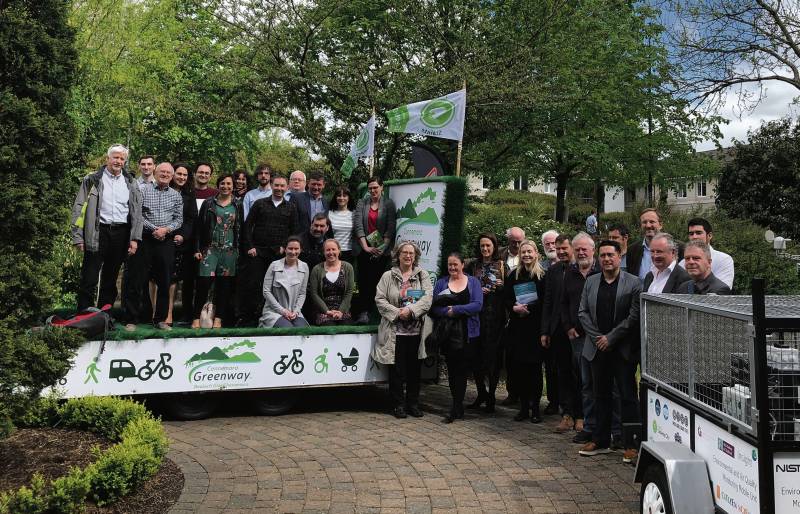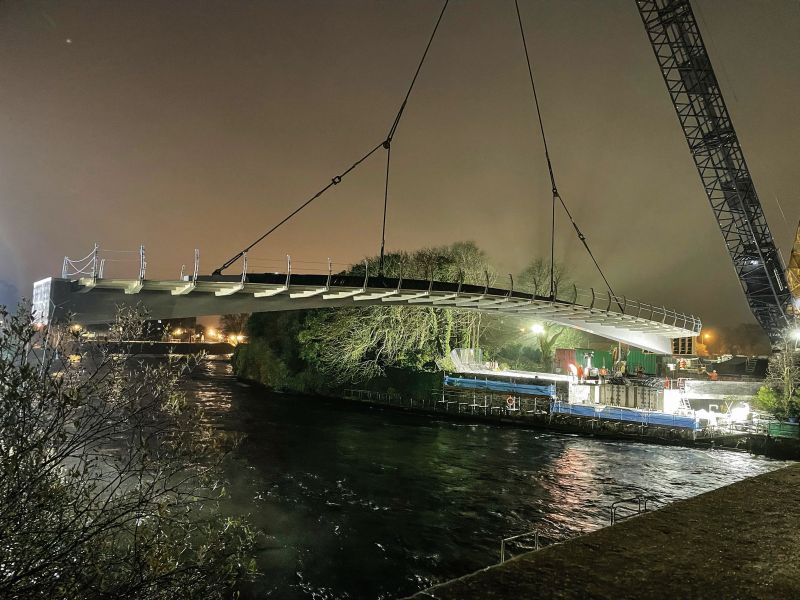CITY TRIBUNE
Campaign to make Galway one of first National Park Cities

The campaign to secure National Park City status for Galway kicked off in earnest on last week, with a launch celebrating the raft of ecological and environmental projects already underway across the city and county.
Spearheaded by veteran environmental campaigner Brendan Smith, this initiative seeks to make Galway one of the first national park cities in the world – something Brendan said couldn’t be more timely as the world faces down the barrel of environmental destruction.
“The world has become disconnected with nature. We have to work together to save ourselves, to save nature and to save the planet,” said Mr Smith.
Launched at the Insight Centre for Data Analytics at NUI Galway, Mr Smith said it was an ideal location to start the campaign, as the connection between technology and environmental action would be key.
“This might seem an unusual place to launch a national park city, but the future is with smart cities and the two have to work together.
“Galway is famous the world over for its arts, and for its science and technology. We have those two big pillars, technology and the arts – the third pillar is the green,” he said.
“We’re more connected than ever before in terms of technology, but in the real world, we’re more disconnected than ever,” he added.
Some 20 speakers from different organisations and groups across the city spoke at the launch, and it was evident that the use of both technology and the arts would be vital to secure national park city designation and promoting the green environment in Galway.
Scientists from NUIG told attendees of their work on citizen science; the creation of a mobile lab with 50 sensors monitoring the atmosphere; an app to identify species of mushrooms; outdoor classrooms and laboratories; managing Ireland’s peatlands; mapping bee habitats; upcycling using 3D printing; and using an app to collect tree data.
Speakers from community and voluntary groups illustrated the importance of Galway’s waterways; the Connemara Greenway as a transport corridor from the west into the city; the urban bee project; and using Merlin Woods as an education centre for flora and fauna.
The Buildings Department at NUIG outlined their work to achieve a green campus, while Scoil Náisiúnta Iognáid (the Jes) showed the work that has gone into their outdoor classroom – with a representation from Our Lady’s College also at the launch.
From the business community, Dangan-based Aerogen outlined how their employees planted 550 trees in Terryland Forest Park during National Tree Week, and have invested in a tree nursery at Ballinfoile Community Garden – a template for businesses to engage with the environmental sector. The tourism sector was also represented with the Nox Hotel in attendance – a hotel located right at the edge of Terryland Forest Park.
This multi-sectoral approach was celebrated by guest of honour, Duncan Stewart, who said Galway was a national leader in environmental issues.
“We should be in a state of panic,” said Mr Stewart. “We should have been in a state of panic 20 years ago.”
“When you look at Ireland, we have the highest greenhouse gas emissions in Europe per person. It’s not just about the little things at the edges – we need to see fundamental change because we are stealing our children’s futures,” added the well-known environmentalist.
CITY TRIBUNE
Galway ‘masterplan’ needed to tackle housing and transport crises

From the Galway City Tribune – An impassioned plea for a ‘masterplan’ that would guide Galway City into the future has been made in the Dáil. Galway West TD Catherine Connolly stated this week that there needed to be an all-inclusive approach with “vision and leadership” in order to build a sustainable city.
Deputy Connolly spoke at length at the crisis surrounding traffic and housing in Galway city and said that not all of the blame could be laid at the door of the local authority.
She said that her preference would be the provision of light rail as the main form of public transport, but that this would have to be driven by the government.
“I sat on the local council for 17 years and despaired at all of the solutions going down one road, metaphorically and literally. In 2005 we put Park & Ride into the development plan, but that has not been rolled out. A 2016 transport strategy was outdated at the time and still has not been updated.
“Due to the housing crisis in the city, a task force was set up in 2019. Not a single report or analysis has been published on the cause of the crisis,” added Deputy Connolly.
She then referred to a report from the Land Development Agency (LDA) that identified lands suitable for the provision of housing. But she said that two-thirds of these had significant problems and a large portion was in Merlin Park University Hospital which, she said, would never have housing built on it.
In response, Minister Simon Harris spoke of the continuing job investment in the city and also in higher education, which is his portfolio.
But turning his attention to traffic congestion, he accepted that there were “real issues” when it came to transport, mobility and accessibility around Galway.
“We share the view that we need a Park & Ride facility and I understand there are also Bus Connects plans.
“I also suggest that the City Council reflect on her comments. I am proud to be in a Government that is providing unparalleled levels of investment to local authorities and unparalleled opportunities for local authorities to draw down,” he said.
Then Minister Harris referred to the controversial Galway City Outer Ring Road which he said was “struck down by An Bord Pleanála”, despite a lot of energy having been put into that project.
However, Deputy Connolly picked up on this and pointed out that An Bord Pleanála did not say ‘No’ to the ring road.
“The High Court said ‘No’ to the ring road because An Bord Pleanála acknowledged it failed utterly to consider climate change and our climate change obligations.
“That tells us something about An Bord Pleanála and the management that submitted such a plan.”
In the end, Minister Harris agreed that there needed to be a masterplan for Galway City.
“I suggest it is for the local authority to come up with a vision and then work with the Government to try to fund and implement that.”
CITY TRIBUNE
Official opening of Galway’s new pedestrian and cycle bridge

The new Salmon Weir pedestrian and cycle bridge will be officially opened to the public next Friday, May 26.
Work on the €10 million bridge got underway in April 2022, before the main structure was hoisted into place in early December.
A lunchtime tape-cutting ceremony will take place on Friday, as the first pedestrians and cyclists traverse the as-yet-unnamed bridge.
The Chief Executive of Galway City Council, Brendan McGrath, previously said the bridge, once opened, would remove existing conflicts between pedestrians, cyclists and traffic “as well as facilitating the Cross-City Link public transport corridor over the existing 200-year-old bridge”.
The naming of the new bridge has been under discussion by the Council’s Civic Commemorations Committee since late last year.
One name that has been in the mix for some time is that of the first woman in Europe to graduate with an engineering degree – Alice Perry.
Ms Perry, who was from Wellpark, graduated from Queen’s College Galway (now University of Galway) in 1906. The university’s engineering building is named in her honour.
The bridge was built by Jons Civil Engineering firm in County Meath and was assembled off-site before being transported to Galway. Funding for the project was provided in full by the National Transport Authority and the European Regional Development Fund.
(Photo: Sheila Gallagher captured the city’s new pedestrian footbridge being raised on the south side of the Salmon Weir Bridge in December. It will officially open next Friday, May 26).
CITY TRIBUNE
Minister branded ‘a disgrace’ for reversing land rezoning in Galway City

From the Galway City Tribune – Minister of State for Local Government and Planning, Kieran O’Donnell was labelled a “disgrace” for overturning councillors’ decisions to rezone land in the new City Development Plan.
Minister O’Donnell (pictured) confirmed in a letter to Council Chief Executive Brendan McGrath last week that he was reversing 25 material alternations made by councillors to the CDP 2023-29. He made the decision on the advice of Office of Planning Regulator (OPR).
Minister O’Donnell directed that 14 land parcels that were subject to land-use zoning changes by councillors as part of the Material Alterations to the Draft CDP should be reversed.
He directed that a further 11 land parcels in the city should become “unzoned”.
The Minister found that the CDP had not been made in a manner consistent with recommendations of the OPR, which required specific changes to the plan to ensure consistency with the national planning laws and guidelines.
At last week’s Council meeting Cllr Eddie Hoare (FG) asked for clarity on the process by which councillors could rezone the lands that had been changed by the Minister’s direction.
Cllr Declan McDonnell said, “What he [Minister O’Donnell] has done is an absolute disgrace”.
And he asked: “Do we have to have another development plan meeting to deal with it?”
Both Cllrs Hoare and McDonnell wondered what would become of the lands that were rezoned or unzoned by the ministerial direction.
Mr McGrath said the Council had put forward an argument in favour of retaining the material alterations in the plan, but ultimately the Minister sided with OPR.
He said if councillors want to make alterations to the new plan, they could go through the process of making a material alteration but this was lengthy.
The Save Roscam Peninsula campaign welcomed the Minister’s decision.
In a statement to the Galway City Tribune, it said the direction would mean the Roscam village area on the Roscam Peninsula will be unzoned and a number of land parcels would revert back to agriculture/high amenity.
A spokesperson for the campaign said: “the material alterations made by city councillors following lobbying by developers continued the long-standing practice of councillors facilitating a developer-led plan rather than an evidence- and policy-based plan that meets the needs of the city.
“The Minister’s direction is an important step in restoring confidence in the planning system. It is clear from the City Council’s own evidence on future housing projections that there was no requirement to zone these lands for residential purposes in order to meet the needs of the targeted population increase up to 2029,” the spokesperson added.















